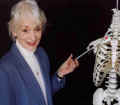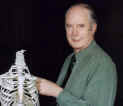 |
 |
 |
Helping You To Achieve ©™

![]()
Helping You To Achieve ©™
|
|
Surface mark the position of the Brachial plexus in the Posterior triangle of the neck on a model in the Anatomical position ,with a time limit of one minute.
Objective No 185 - Criteria to be demonstrated. 1. Request the model to rotate the Cervical spine to the right through 70 degrees and side flex to the left against slight resistance to demonstrate the action of the Left Sternomastoid (Objective No 174) 2. Mark the posterior border of the Sternomastoid, superior border of the shaft of Clavicle (Objective No 2) and anterior border of the Upper fibres of Trapezius (Objective No 29). 3. Note the position and borders of the above structures which form the Posterior Triangle of the Neck, 4. Identify and mark the mid-point of the posterior border of Sternomastoid. 5. Identify and mark the mid-point of the shaft of Clavicle. 6. Draw a line between the marked points in steps 4 and 5. 7. The Trunks of the Brachial plexus pass downwards and in a lateral direction within the supra-clavicular area (as marked out in steps 4, 5 and 6) of the Posterior Triangle of the Neck 8. The Trunks of the Brachial plexus pass between the Clavicle and First Rib into the Axilla and form three Cords.
|
Service ProvisionBronze. Students may take up a ,'Free start up ' package consisting of 100 of the behavioural objectives and criteria based on common questions asked in Living Anatomy. These are available free of charge on this Website. Silver. Students may buy a copy of the book "Surface and Living Anatomy" (ISBN: 0 7234 3261 9) which comes with a CD Rom (Windows PC format) containing 230 objectives which includes the 100 behavioural objectives contained in the Bronze Service. Gold "Helping you to Achieve" Contact Information
|